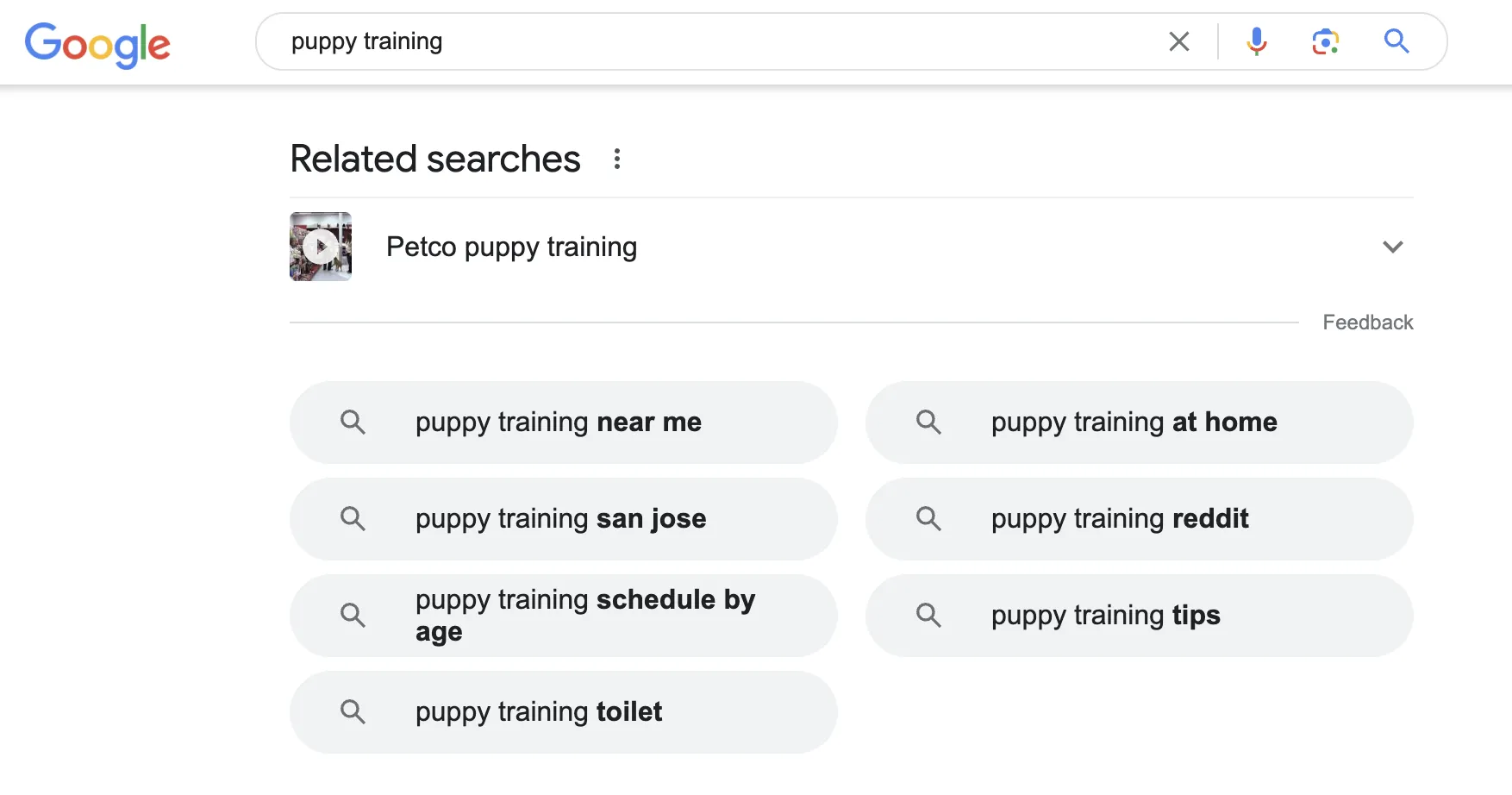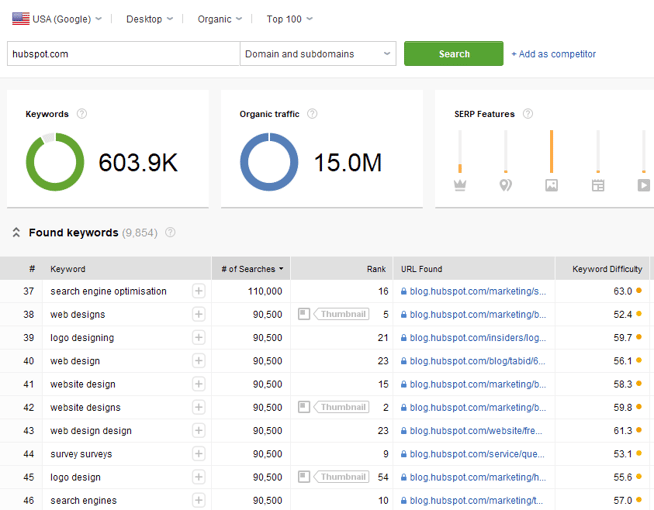While Google keeps us on our toes with all the algorithm updates they keep rollin' out, one thing has stayed pretty consistent for inbound marketers looking to optimize their websites for search: keyword research.

In this post, we’ll define what keyword research is, why it’s important, how to conduct your research for your SEO strategy, and choose the right keywords for your website.
Table of Contents
- What is keyword research?
- Why is keyword research important?
- Elements of Keyword Research
- How to Research Keywords for Your SEO Strategy
- How to Find and Choose Keywords for Your Website
What is keyword research?
Keyword research is the process of finding and analyzing search terms that people enter into search engines with the goal of using that data for a specific purpose, often for search engine optimization (SEO) or general marketing. Keyword research can uncover queries to target, the popularity of these queries, their ranking difficulty, and more.
Why is keyword research important?
Keyword research helps you find which keywords are best to target and provides valuable insight into the queries that your target audience is actually searching on Google.
Insights from these actual search terms can help inform your content strategy as well as your larger marketing strategy.
People use keywords to find solutions when conducting research online.
So if your content is successful in getting in front of your audience as they conduct searches, you stand to gain more traffic. Therefore, you should be targeting those searches with content that features those keywords in a meaningful way.
Additionally, inbound methodology focuses less on creating content around what we want to tell people. Instead, we should be creating content around what people want to discover.
In other words, our audience is coming to us for helpful content that provides the answers they’re looking for.
In a nutshell, all of this starts with keyword research.
Conducting keyword research has many benefits, the most popular being:
Marketing Trend Insight
Conducting effective keyword research can provide you with insights into current marketing trends and help you center your content on relevant topics and keywords your audience is in search of.
Traffic Growth
When you identify the best-fitting keywords for the content you publish, the higher you’ll rank in search engine results — the more traffic you’ll attract to your website.
Customer Acquisition
If your business has content that other business professionals are looking for, you can meet their needs and provide them with a call-to-action that will lead them into the buyer journey from the awareness stage to the point of purchase.
By researching keywords for their popularity, search volume, and general intent, you can tackle the questions that most people in your audience want answers to.
Keywords vs. Topics
More and more, we hear how much SEO has evolved over just the last 10 years and how seemingly unimportant keywords have transformed our ability to rank well for the searches people make every day.
And to some extent, this is true, but in the eyes of an SEO professional, it’s a different approach. Rather, it’s the intent behind that keyword and whether or not a piece of content solves for that intent (we’ll talk more about intent in just a minute).
But that doesn’t mean keyword research is an outdated process. Let me explain:
Keyword research tells you what topics people care about and, assuming you use the right SEO tool, how popular those topics actually are among your audience.
The operative term here is topics, plural. By researching keywords that are getting a high volume of searches per month, you can identify and sort your content into topics or buckets that you want to create content on.
Then, you can use these topics to dictate which keywords you look for and target.

Keyword Research Template
Build your SEO strategy with this free template.
- Search Volume
- CPC
- Ranking
- Keyword Difficulty
Elements of Keyword Research
There are three main elements I have discovered that you should pay attention to when conducting keyword research.
1. Relevance
Google ranks content for relevance.
This is where the concept of search intent comes in. Your content will only rank for a keyword if it meets the searchers’ needs.
In addition, your content must be the best resource out there for the query. After all, why would Google rank your content higher if it provides less value than other content that exists on the web?
2. Authority
Google will provide more weight to sources it deems authoritative.
That means you must do all you can to become an authoritative source by enriching your site with helpful, informative content and promoting that content to earn social signals and backlinks.
If you’re not seen as authoritative in the space, or if a keyword’s SERPs are loaded with heavy sources you can’t compete with (like Forbes or The Mayo Clinic), you have a lower chance of ranking unless your content is exceptional.
3. Volume
You may end up ranking on the first page for a specific keyword, but if no one ever searches for it, it will not result in traffic to your site. It's like setting up a shop in a ghost town.
Volume is measured by MSV (monthly search volume), which means the number of times the keyword is searched per month across all audiences.
How to Research Keywords for Your SEO Strategy
- Make a list of important, relevant topics based on what you know about your business.
- Fill in those topic buckets with keywords.
- Understand how intent affects keyword research and analyze accordingly.
- Research related search terms.
- Use keyword research tools to your advantage.
I’m going to lay out a keyword research process you can follow to help you come up with a list of terms you should be targeting.
That way, you’ll be able to establish and execute a strong keyword strategy that helps you get found for the search terms you actually care about.
Step 1. Make a list of important, relevant topics based on what you know about your business.
To kick off this process, think about the topics you want to rank for in terms of generic buckets.
You’ll come up with about five to 10 topic buckets you think are important to your business, and then you’ll use those topic buckets to help come up with some specific keywords later in the process.
If you’re a regular blogger, these are probably the topics you blog about most frequently. Or perhaps they’re the topics that come up the most in sales conversations.
Put yourself in the shoes of your buyer personas. What types of topics would your target audience search that you’d want your business to get found for?
If you were a company like HubSpot, for example — selling marketing software (which happens to have some awesome SEO tools... but I digress), you might have general topic buckets like:
- “inbound marketing” (6.6K).
- “blogging” (90.5K).
- “email marketing” (22.2K).
- “lead generation” (18.1K).
- “SEO” (110K).
- “social media marketing” (40.5K).
- “marketing analytics” (5.4K).
- “marketing automation” (85.4K).
See those numbers in parentheses to the right of each keyword? That’s their monthly search volume.
This data allows you to gauge how important these topics are to your audience and how many different sub-topics you might need to create content on to be successful with that keyword.
To learn more about these sub-topics, we move on to step two.
Step 2. Fill in those topic buckets with keywords.
Now that you have a few topic buckets you want to focus on, it’s time to identify some keywords that fall into those buckets.
These are keyword phrases you think are important to rank for in the SERPs (search engine results pages) because your target customer is probably conducting searches for those specific terms.
For instance, if I took that last topic bucket for an inbound marketing software company — “marketing automation” — I’d brainstorm some keyword phrases that I think people would type in related to that topic.
Those might include:
- marketing automation tools
- how to use marketing automation software
- what is marketing automation?
- how to tell if I need marketing automation software
- lead nurturing
- email marketing automation
- top automation tools
And so on and so on. The point of this step isn’t to come up with your final list of keyword phrases.
You just want to end up with a brain dump of phrases you think potential customers might use to search for content related to that particular topic bucket.
We’ll narrow the lists down later in the process so you don’t have something too unwieldy.
Keep in mind that more and more keywords are getting encrypted by Google every day, so another smart way to come up with keyword ideas is to figure out which keywords your website is already getting found for.
To do this, you’ll need website analytics software like Google Analytics, Google Search Console, or HubSpot’s Sources report, available in the Traffic Analytics tool.
Drill down into your website’s traffic sources, and sift through your organic search traffic bucket to identify the keywords people are using to arrive at your site.
Repeat this exercise for as many topic buckets as you have.
Remember, if you’re having trouble coming up with relevant search terms, you can always head on over to your customer-facing colleagues — those who are in sales or service. Ask them what types of terms their prospects or customers have questions about.
Those are often great starting points for keyword research.
Here at HubSpot, we use the Search Insights Report in this part of the process. This template is designed to help you do the same and bucket your keywords into topic clusters, analyze MSV, and inform your editorial calendar and strategy.
Featured Resource: Search Insights Report Template
Step 3. Understand how intent affects keyword research and analyze accordingly.
Like I said in the previous section, user intent is now one of the most pivotal factors in your ability to rank well on search engines like Google.
Today, it’s more important that your web page addresses the problem a searcher intended to solve than simply carries the keyword the searcher used. So, how does this affect the keyword research you do?
It’s easy to take keywords at face value, but unfortunately, keywords can have many different meanings beneath the surface.
Because the intent behind a search is so important to your ranking potential, you need to be extra careful about how you interpret the keywords you target.
Let’s say, for example, you’re researching the keyword “how to start a blog” for an article you want to create. “Blog” can mean a blog post or the blog website itself, and what a searcher’s intent is behind that keyword will influence the direction of your article.
Does the searcher want to learn how to start an individual blog post? Or do they want to know how to actually launch a website domain for the purposes of blogging?
If your content strategy is only targeting people interested in the latter, you’ll need to make sure of the keyword’s intent before committing to it.
To verify what a user’s intent is in a keyword, it’s a good idea to simply enter this keyword into a search engine yourself and see what types of results come up.
Make sure the type of content Google is displaying relates to your intention for the keyword.
Step 4. Research related search terms.
This is a creative step you may have already thought of when doing keyword research. If not, it’s a great way to fill out those lists.
If you’re struggling to think of more keywords people might be searching about a specific topic, take a look at the related search terms that appear when you plug in a keyword into Google.
When you type in your phrase and scroll to the bottom of Google’s results, you’ll notice some suggestions for searches related to your original input.
These keywords can spark ideas for other keywords you may want to take into consideration.

Want a bonus? Type in some of those related search terms and look at their related search terms.
Step 5. Use keyword research tools to your advantage.
Keyword research and SEO tools can help you come up with more keyword ideas based on exact match keywords and phrase match keywords based on the ideas you’ve generated up to this point.

Keyword Research Template
Build your SEO strategy with this free template.
- Search Volume
- CPC
- Ranking
- Keyword Difficulty
Some of the most popular ones include:
1. Ahrefs Webmaster Tools
Some of the best SEO reports and keyword research I’ve seen have come from SEO experts using Ahrefs Keywords Explorer.
Their webmaster tools offer plenty of detail into any verified domains you own if you’re looking for an overview of backlinks and organic keywords.
2. SE Ranking
I found SE Ranking was not quite as user-friendly to dive into as some of the other options. When I typed in my keyword “keyword research,” I was prompted to set up a free 7-day trial, and it immediately asked for the domain I wanted to track.
While it gave me some good intro data, I had to do some digging to get to the keyword research and keyword suggestion tools. However, when I found them, the resulting data was comprehensive and gave me lots of great ideas.
And, it didn’t make me put in a credit card to take the tool for a spin, which is always a plus in my book.
3. SEMrush Keyword Magic Tool
Semrush is one of the most comprehensive SEO companies out there, so I wasn’t surprised to find that their keyword magic tool was comprehensive as well.
While you do need to set up an account, it’s free. Then, you can type in your keyword, get a list of similar keywords, and sort based on how specific you need your results to be.
4. Ubersuggest
I’ve been a fan of Ubersuggest for quite some time. You get up to three free searches a day, and it’s so easy to use.
In addition to finding out specific keyword performance, you can find related keywords, and you can also do a quick reverse search to find out what your site is already ranking for.
It’s one of the easiest, most comprehensive free options, if you don’t mind the limitations of the free searches.
5. Free Keyword Research Tool
I found Ryrob’s keyword research tool easy to use. When I plugged “keyword research” into the “Explorer” tab as my keyword, it gave me several related keywords that could be solid blog topics.
Then, when I shifted over to the “Ideas” tab, it gave me other keyword cluster ideas that are more likely to be specific search terms that I might want to include in future articles on keyword research.
6. Google Keyword Planner
Google’s tools are always gold. They’re free, and it’s always good to get the info straight from the horse’s mouth. Once you sign in with your Google account, you can search for keyword ideas based on the keyword or your website.
After plugging in my website, I got a list of 637 target keyword ideas, and I frantically started messaging my VA with about two dozen of them and a reminder to “ping me in our next meeting” so I don’t lose track of these ideas!
7. Keywords Everywhere
Keywords Everywhere has been highly recommended by several people I know.
Here’s what I learned — it’s a browser extension that’s not quite free and takes a little more setup than some of the browser-based options, but at $15/year, it’s accessible to most people.
Once I installed and configured the extension, it was super easy to sign up for their lowest-tier package.
Better yet, it’s not one-and-done. And I don’t have to log into a platform every time I want to check on keywords.
Every time I do a Google search, I get data about related keywords and similar searches, which gives me lots of ideas for new content. (And, of course, I searched “keyword research.” Why not?)
For the price and the detail, it’s one of my favorite tools.
8. KeywordTool.io
Basically, using KeywordTool.io is exactly what they promise in the headline. When I typed in “keyword research,” I got a list of 502 keyword ideas.
Although I only see search volume, trend, CPC, and competition for the first five, I can see all of the keywords, which provides a solid search starting point.
9. KWFinder
KWFinder is another easy tool. While I quickly found that an account is needed to get started, it’s free and quite easy to dive in. I was able to quickly start finding the top keywords.
10. SearchVolume.io
When I plugged in a handful of keywords into SearchVolume.io, after doing a quick “Are you a human?” check, the monthly search volume immediately popped out.
A quick cross-comparison with other tools showed that the data was consistent with other platforms.
11. Rank Tracker
Rank Tracker by SEO PowerSuite is a solid tool for monitoring SERP data and doing keyword research. There are a lot of great features, but Rank Tracker serves best as a tool to rank relevant keywords, identify keyword gaps, and autocomplete phrases on different search engine tools.
Rank Tracker allows you to see all the phrases a particular domain ranks for, along with search volumes and keyword difficulty. Their keyword gap tool allows you to find out which keywords competing websites are ranking for that you might be missing out on. Rank Tracker also integrates with Google Search Console and Keyword Planner, providing a free version for unlimited testing.
How to Find and Choose Keywords for Your Website
- Use Google Keyword Planner to cut down your keyword list.
- Prioritize low-hanging fruit.
- Check the monthly search volume (MSV) for keywords you’ve chosen.
- Factor in SERP features as you choose keywords.
- Check for a mix of head terms and long-tail keywords in each bucket.
- See how competitors are ranking for these keywords.
Once you have an idea of the keywords that you want to rank for, now it's time to refine your list based on the best ones for your strategy. Here’s how.
Step 1. Use Google Keyword Planner to cut down your keyword list.
In Google’s Keyword Planner, you can get search volume and traffic estimates for keywords you’re considering. Then, take the information you learn from Keyword Planner and use Google Trends to fill in some blanks.
Use the Keyword Planner to flag any terms on your list that have way too little (or way too much) search volume and don’t help you maintain a healthy mix like we talked about above.
But before you delete anything, check out their trend history and projections in Google Trends. You can see whether, say, some low-volume terms might actually be something you should invest in now — and reap the benefits later.
Or perhaps you’re just looking at a list of terms that is way too unwieldy, and you have to narrow it down somehow. Google Trends can help you determine which terms are trending upward and are, therefore, worth more of your focus.

Keyword Research Template
Build your SEO strategy with this free template.
- Search Volume
- CPC
- Ranking
- Keyword Difficulty
Step 2. Prioritize low-hanging fruit.
What I mean by prioritizing low-hanging fruit is to prioritize keywords that you have a chance of ranking for based on your website’s authority.
Large companies typically go after high search volume keywords, and since these brands are well established already, Google typically rewards them with authority over many topics.
You can also consider keywords that have little competition. Keywords that don’t already have multiple articles battling for the highest rank can afford you the spot by default — if there’s no one else trying to claim it.
Step 3. Check the monthly search volume (MSV) for keywords you’ve chosen.
You want to write content around what people want to discover, and checking MSV can help you do just that.
Monthly search volume is the number of times a search query or keyword is entered into search engines each month.
Tools like searchvolume.io or Google Trends can help you find out the most searched keywords over related keyword clusters for free.
Step 4. Factor in SERP features as you choose keywords.
There are several SERP feature snippets that Google will highlight if used correctly.
An easy way to find out about them is to look up the keywords of your choosing and see what the first result looks like. But for a quick overview of the types of SERP featured snippets, we’ll summarize what they are here.
Image Packs
Image packs are search results displayed as a horizontal row of images that appear in an organic position. If there’s an image pack, you should write an image-heavy post to win placement in it.
Paragraph Snippets
Featured snippets, or paragraph snippets, are short snippets of text that appear at the top of Google search results for quick answers to common search queries.
Understanding the searcher’s intent and providing succinct, concise answers can help in winning the placement.
List Snippets
List snippets, or listicles, are snippets made for posts outlining steps to do something from start to finish — often for “How To” searches. Making posts with direct, clear instructions and formatting can assist in winning this placement.
Video Snippets
Video snippets are short videos that Google will display at the top of a search query page in place of text featured snippets.
Posting a video on both YouTube and your website can help you win this placement if tagged in the targeted keywords people are searching for.
Step 5. Check for a mix of head terms and long-tail keywords in each bucket.
Head terms are keyword phrases that are generally shorter and more generic — they’re typically just one to three words in length, depending on who you talk to.
Long-tail keywords, on the other hand, are longer keyword phrases usually containing three or more words.
It’s important to check that you have a mix of head terms and long-tail terms because it’ll give you a keyword strategy that’s well-balanced with long-term goals and short-term wins.
That’s because head terms are generally searched more frequently, making them often (not always, but often) much more competitive and harder to rank for than long-tail terms.
Think about it: Without even looking up search volume or difficulty, which of the following terms do you think would be harder to rank for?
- how to write a great blog post
- blogging
If you answered #2, you’re absolutely right.
But don’t get discouraged. While head terms generally boast the most search volume (meaning greater potential to send you traffic), frankly, the traffic you’ll get from the term “how to write a great blog post” is usually more desirable.
Why?
Because someone who is looking for something that specific is probably a much more qualified searcher for your product or service (presuming you’re in the blogging space) than someone looking for something really generic.
Because long-tail keywords tend to be more specific, it’s usually easier to tell what people who search for those keywords are really looking for. Someone searching for the head term “blogging,” on the other hand, could be searching it for a whole host of reasons unrelated to your business.
So check your keyword lists to make sure you have a healthy mix of head terms and long-tail keywords. You definitely want some quick wins that long-tail keywords will afford you, but you should also try to chip away at more difficult head terms over the long haul.
Step 6. See how competitors are ranking for these keywords.
Just because your competitor is doing something doesn’t mean you need to. The same goes for keywords. Just because a keyword is important to your competitor doesn’t mean it’s important to you.
However, understanding what keywords your competitors are trying to rank for is a great way to help you give your list of keywords another evaluation.
If your competitor is ranking for certain keywords that are on your list, too, it definitely makes sense to work on improving your ranking for those.
Don’t ignore the ones your competitors don’t seem to care about. This could be a great opportunity for you to own market share on important terms, too.
Understanding the balance of terms might be a little more difficult. Remember, the goal is to end up with a list of keywords that provides some quick wins but also helps you make progress toward bigger, more challenging SEO goals.
How do you figure out what keywords your competitors are ranking for, you ask? You can manually search for keywords in an incognito browser and see what positions your competitors are in.
Beyond that, the code Arel=“noopener” target=“_blank” hrefs allows you to run a number of free reports that show you the top keywords for the domain you enter.
This is a quick way to get a sense of the types of terms your competitors are ranking for.
Best Keywords for SEO
Understand that there are no “best” keywords, just those that are highly searched by your audience. With this in mind, it’s up to you to craft a strategy that will help you rank pages and drive traffic.
The best keywords for your SEO strategy will take into account relevance, authority, and volume. You want to find highly searched keywords that you can reasonably compete for based on:
- The level of competition you’re up against.
- Your ability to produce content that exceeds in quality what’s currently ranking.
And You’ve Got the Right Keywords for Your Website SEO
You now have a list of keywords that’ll help you focus on the right topics for your business and get you some short-term and long-term gains.
Be sure to re-evaluate these keywords every few months — once a quarter is a good benchmark, but some businesses like to do it even more often than that.
As you gain even more authority in the SERPs, you’ll find that you can add more and more keywords to your list.
Editor's note: This post was originally published in May 2019 and has been updated for comprehensiveness.
![Download Now: Keyword Research Template [Free Resource]](https://no-cache.hubspot.com/cta/default/53/447dd5f8-1426-4fb6-af75-b6e55bb759a2.png)






![The Definition of a Long-Tail Keyword [In Under 100 Words]](https://blog.hubspot.com/hs-fs/hub/53/file-616662343-jpg/Blog_Thinkstock_Images/monkey.jpg)

![How to Use Keyword Tools to Brainstorm Blog Topics [Quick Tip]](https://blog.hubspot.com/hs-fs/hub/53/file-31261834-jpg/Blog-Related_Images/blog-topics.jpg)

